Stacked And Scattered
Federico Campanale, Constant Dullaart, Thijs Gadiot, Nico Jungmann, George Korsmit, Frank Mandersloot, Henny Overbeek, Boris Tellegen“Calling something random simply means I don’t understand how two phenomena interrelate.”
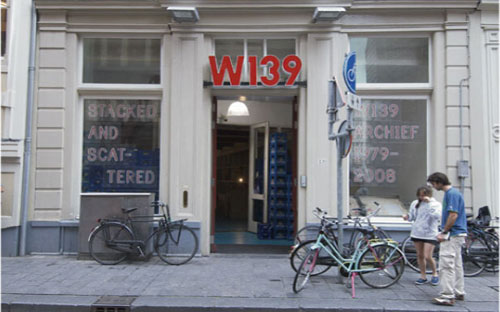
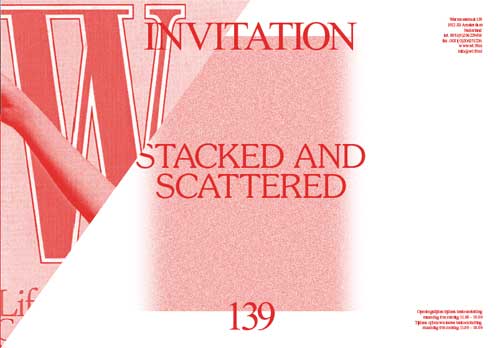
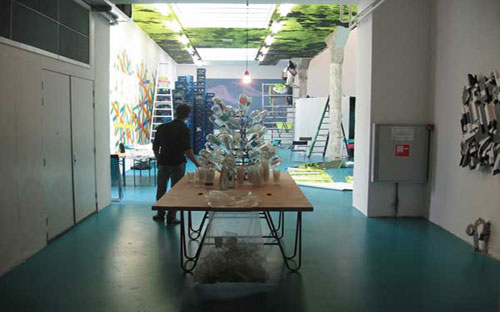
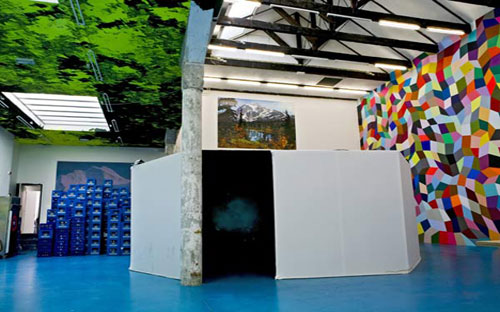

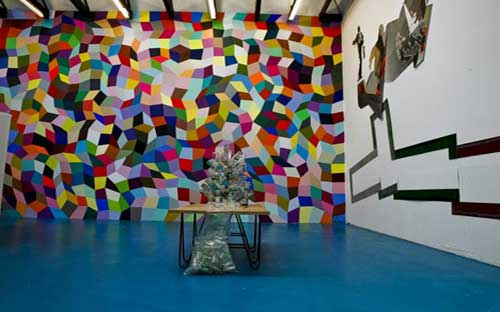
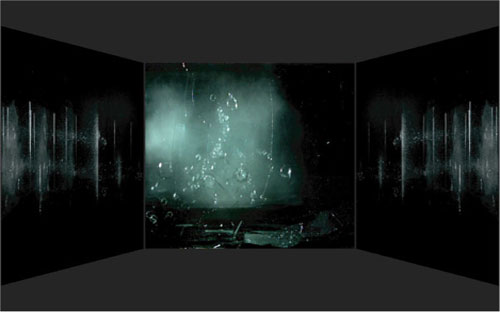
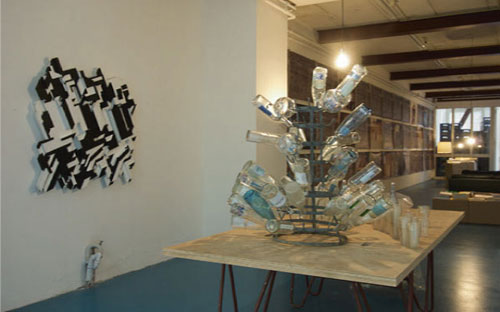
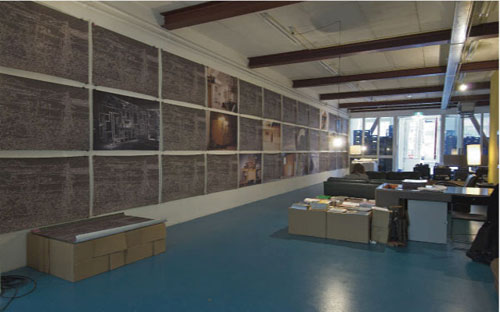
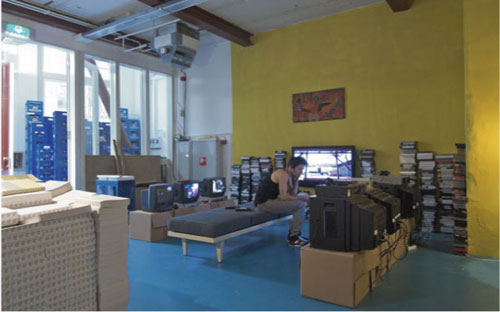
George Korsmit One of painting’s highest aspirations is to realise a field of infinite perception. A surface where the gaze of the viewer has total freedom yet still hungry to go on exploring. This process is blocked by every fixed meaning, and obvious meaninglessness will not engage any viewer’s attention. The ideal painterly surface is at once random and systematic. The quest for visual randomness is a minor yet insistent thread running through the fabric of contemporary art. The enormous mural George Korsmit is painting on the wall of the rear space at W139 this summer is an intoxicating episode in this project. For five weeks, Korsmit and his five assistants will work from a platform on a mobile scaffold. The corners of a grid and the colours used to fill it in are decided within specific parameters by throwing dice. The angles are drawn, the sections taped off, the paint mixed and applied. What results is a horizontal sequence of colourful tetragons, a mosaic in which the eye wanders endlessly, searching for difference, similarity and pattern. Without romantic connotations, Korsmit’s paintings evoke an authority comparable to the experience of gazing into an immense, clear, star-studded night sky.
Federico Campanale The sight and sound of shattering glass can summon up an intense sense of wellbeing. This feeling of liberation and satisfaction is often hard to place because something is clearly being destroyed for good. You could say that any solid material is constrained in a shape. Like glass, which in essence is a very elastic kind of syrup, is in a state of extreme tension in solid form. Shattering a pane of glass literally releases it and part of our response is clearly capable of identifying with the way physical materials can change states. Kogel Vogel is a high speed recording of a bullet passing through seven sheets of glass stacked one after the other. The slow-motion traces of the sequence of shattered panes and the rain of glass fragments was filmed from different vantage points and edited into an awe-inspiring film, accompanied by the sound created by the breaking glass.
Constant Dullaart Stacking, doubling and recycling are the constants in Dullaart’s young conceptual oeuvre. For Stacked & Scattered he will stack a mountain of bottle crates to create “the face of the Jungfrau”; the mural by Peter Vos. Vos found inspiration for this work in the photo wallpaper discovered in the basement of the Post CS building when W139 moved. The wallpaper turned out to be a depiction of the Jungfrau. During the opening of Stacked & Scattered Dullaart’s installation will act as a bar.
Thijs Gadiot Has made a machine that, directed by a computer, draws, stamps and writes with a marker On A2 paper. De title on the front Windows is writen by the machine and it is in action during the entire show. Frank Mandersloot The oeuvre of Frank Mandersloot shifts seamlessly between commonplace objects and works of art. Everyday usage is always materially interwoven with larger, more comprehensive conceptual networks and natural processes. Using simple materials and existing objects, Mandersloot constructs a constellation that, like a mental machine, triggers viewers’ acts and thought processes. The sculpture “Water to water” (2008) comprises a large assortment of bottled water and stacks of plastic cups set out on a heavy trestle table. A metal bottle rack stands to one side, ready to receive the empty bottles. On the other an ingenious system holds a plastic bin liner for the disposal of the empty cups. That is the sculpture. Its force lies in its jibe at our decadent obsession with the packaging of life’s necessities; but the piece is always explicit, and never moralistic. Because the artist (by buying the water) and the viewer (by drinking it) participate in the work through their actions, we are made aware of the passage of water through the natural world, the commercial world and our bodies. Within this global journey, our gaze is directed at the shapes and colours of the newly washed glass, and the individualised bottles are superlatively restored to beauty.
Boris Tellegen and Henny van Overbeek The murals and objects of Boris Tellegen are boundless both in their distribution and appearance. The “Master of 3D” works on trains and walls, and in museums and on the internet. His world, built up of complex orthogonal modules, expands in all directions with an apparent aimlessness and is both part of – and a reflection on - graffiti.
The murals by Terry Haggerty and Sonia Rijnhout and the triplex piece by Gary Stephan from “Unlikely”, the last W139 exhibition on abstract painting from New York and Germany, will be integrated into the current exhibition. The work by Gary Stephan was mentioned during the presentation of Burn & Learn, a fascinating publication exploring the essence of graffiti. Which graffiti artist had created the piece? No one realised it was in fact a remake of a work created in 1972 by a 65-year old New York artist. Henny van Overbeek is creating a new piece that specifically reacts to Stephan’s and by doing so is the first step in a series of artistic reflections in W139 in which an artists creates a piece in dialogue with a previous artist.
Nico Jungmann “De Kevelaar processie” is a painting by Nico Jungmann (1872-1935 from 1899. The devoted gaze of the men and women in traditional dress, lit by torches and lanterns, the late evening light that shows the trees and leaves as dark yet still green, and the central body of water reflecting all that light, makes the work a counterpoint in Stacked & Scattered. It is an intense evocation of the profound relationship between villagers and their village, nature and the forms of their religious procession. The painting, executed on an oak panel, is part of the collection of the Zuiderzeemuseum and is on display in W139 as a prelude to the “All Souls” procession W139 is organising on 1 November 2008. This art procession is a work by Elena Belaarts, Floris Tilanus and Henk Jan Bouwmeester.
Archive 1979-2008 There is a time to collect stones and a time to throw them away. Ecclesiastes Scouring the W139 archive is exciting and alarming; exciting because, each year, you look back in amazement at the incredible exhibitions of the last 29 years; alarming because it’s almost impossible to think of something that hasn’t already been tried in W139. One example of this phenomenon is the large number of houses artists built over the years as protection from W139’s imposing scale. We have selected ten of them. Sofas, chairs and lamps have been set out in the front space of W139 so you can look through the videos, photo books, posters and artworks left behind, that make up the W139 archive. The poster by artist and graphic designer Kasper Andreassen with the names of every artist who ever exhibited in W139 is on display and on sale. You can also buy a well-priced book series to brush up your W139 knowledge and, even if you don’t read it all, it will be a valuable addition to your library! Outside, on the Oudezijds Voorburgwal, the exhibition continues with a number of life-size prints from the W139 photo archive. This part of the exhibition has been realised in collaboration with Woonstichting de Key.